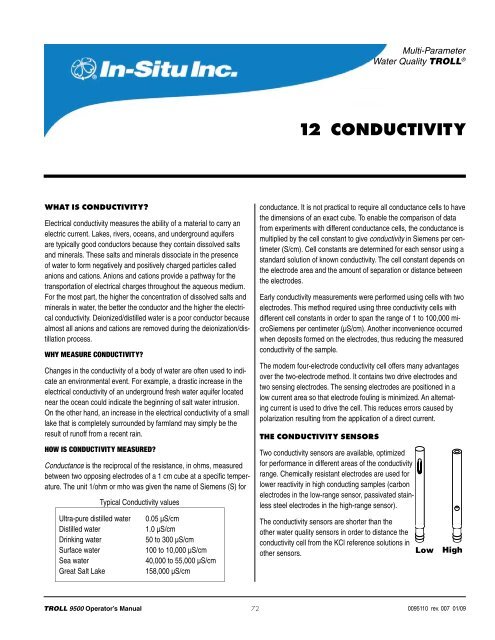TROLL 9500 Operator's Manual - Geotech Environmental Equipment
TROLL 9500 Operator's Manual - Geotech Environmental Equipment
TROLL 9500 Operator's Manual - Geotech Environmental Equipment
Create successful ePaper yourself
Turn your PDF publications into a flip-book with our unique Google optimized e-Paper software.
Multi-ParameterWater Quality <strong>TROLL</strong> ®12 ConductivityWhat Is Conductivity?Electrical conductivity measures the ability of a material to carry anelectric current. Lakes, rivers, oceans, and underground aquifersare typically good conductors because they contain dissolved saltsand minerals. These salts and minerals dissociate in the presenceof water to form negatively and positively charged particles calledanions and cations. Anions and cations provide a pathway for thetransportation of electrical charges throughout the aqueous medium.For the most part, the higher the concentration of dissolved salts andminerals in water, the better the conductor and the higher the electricalconductivity. Deionized/distilled water is a poor conductor becausealmost all anions and cations are removed during the deionization/distillationprocess.Why Measure Conductivity?Changes in the conductivity of a body of water are often used to indicatean environmental event. For example, a drastic increase in theelectrical conductivity of an underground fresh water aquifer locatednear the ocean could indicate the beginning of salt water intrusion.On the other hand, an increase in the electrical conductivity of a smalllake that is completely surrounded by farmland may simply be theresult of runoff from a recent rain.How is Conductivity Measured?Conductance is the reciprocal of the resistance, in ohms, measuredbetween two opposing electrodes of a 1 cm cube at a specific temperature.The unit 1/ohm or mho was given the name of Siemens (S) forUltra-pure distilled waterDistilled waterDrinking waterSurface waterSea waterGreat Salt LakeTypical Conductivity values0.05 µS/cm1.0 µS/cm50 to 300 µS/cm100 to 10,000 µS/cm40,000 to 55,000 µS/cm158,000 µS/cmconductance. It is not practical to require all conductance cells to havethe dimensions of an exact cube. To enable the comparison of datafrom experiments with different conductance cells, the conductance ismultiplied by the cell constant to give conductivity in Siemens per centimeter(S/cm). Cell constants are determined for each sensor using astandard solution of known conductivity. The cell constant depends onthe electrode area and the amount of separation or distance betweenthe electrodes.Early conductivity measurements were performed using cells with twoelectrodes. This method required using three conductivity cells withdifferent cell constants in order to span the range of 1 to 100,000 microSiemensper centimeter (µS/cm). Another inconvenience occurredwhen deposits formed on the electrodes, thus reducing the measuredconductivity of the sample.The modern four-electrode conductivity cell offers many advantagesover the two-electrode method. It contains two drive electrodes andtwo sensing electrodes. The sensing electrodes are positioned in alow current area so that electrode fouling is minimized. An alternatingcurrent is used to drive the cell. This reduces errors caused bypolarization resulting from the application of a direct current.The Conductivity SensorsTwo conductivity sensors are available, optimizedfor performance in different areas of the conductivityrange. Chemically resistant electrodes are used forlower reactivity in high conducting samples (carbonelectrodes in the low-range sensor, passivated stainlesssteel electrodes in the high-range sensor).The conductivity sensors are shorter than theother water quality sensors in order to distance theconductivity cell from the KCl reference solutions inother sensors. Low High<strong>TROLL</strong> <strong>9500</strong> Operator’s <strong>Manual</strong>720095110 rev. 007 01/09
















